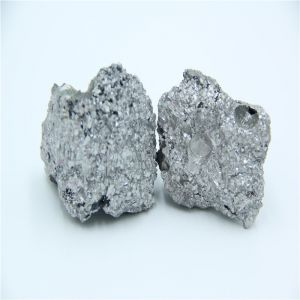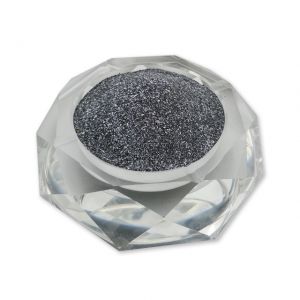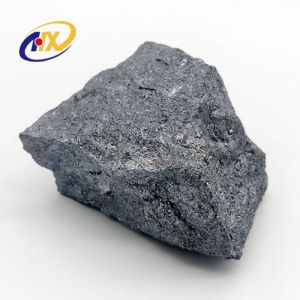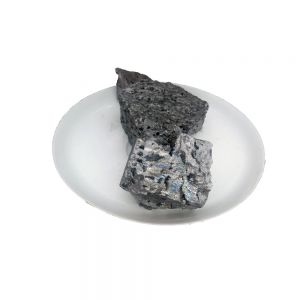Detailed explanation of the performance and uses of inoculants for castings
Dec 11, 2023 / 369 views
What is an inoculant?
Inoculant is an alloy additive used to improve the properties of cast iron.
The main function of the inoculant is to improve the strength, toughness and wear resistance of cast iron by promoting graphitization, reducing the tendency of whitening, improving the morphology and distribution of graphite, increasing the number of eutectic groups, and refining the matrix structure.
Inoculants are usually used in the inoculation process of cast iron production. They are added to the molten iron to evenly distribute them in the cast iron, thereby improving the properties of the cast iron. The type and composition of inoculants vary depending on the type of cast iron and production requirements. The selection of appropriate inoculants is of great significance to improving the performance of cast iron.
In addition, inoculants can also be used in the inoculation treatment of steel materials to improve their performance and organizational structure.
What types of inoculants are there?
The types of inoculants vary depending on their ingredients and uses. Here are some common types of inoculants:
1.75 ferrosilicon
75 Ferrosilicon is a commonly used inoculant. The aluminum and calcium content in it play an important role in the inoculation effect. There are reports that ferrosilicon without aluminum and calcium has little or even no effect on the inoculation of gray cast iron. It is generally believed that in molten iron, aluminum and calcium will react with oxygen and nitrogen to form high melting point compounds, which become the core of graphite crystallization. Moreover, after adding inoculant, local silicon-rich micro-areas can be formed in the molten iron, which is conducive to graphite precipitation. When purchasing ferrosilicon for inoculation, the aluminum and calcium content must be considered.
For ferrosilicon 75 used as an inoculant, relevant American standards stipulate that the aluminum content is 0.75 to 1.75% and the calcium content is 0.5 to 1.5%. There are 75 ferrosilicon grades with different aluminum contents in our country's standard GB/T 2272-1987. The upper limits of aluminum content are 0.5%, 1.0%, 1.5% and 2.0% respectively, and the upper limit of calcium content is 1.0%. . However, the aluminum content in the molten iron cannot be too high. Adding 0.01% aluminum may cause subcutaneous pores in the casting. This should also be considered when selecting the type of inoculant and determining the dosage of inoculant.
2. Ferrosilicon containing strontium
Strontium-containing ferrosilicon has a strong ability to eliminate white spots, which is especially beneficial to improving the shape and distribution of graphite in thin-walled castings, making the difference in structure at different thicknesses smaller, and the supercooled structure is only seen on the surface of the casting.
At present, my country has supplies of strontium-containing ferrosilicon, with strontium content ranging from 0.6 to 1.0% and 1.0 to 2.0%. Generally, varieties containing 0.6 to 1.0% strontium can be selected. If the strontium content is too high, its effect will not be fully exerted.
The addition amount of strontium-containing ferrosilicon is about half of that of 75 ferrosilicon.
3. Barium ferrosilicon
Barium-containing ferrosilicon also has a strong ability to promote graphitization, which can improve the morphology and distribution of graphite in thin-walled castings. It also has the effect of slowing down the growth and decay, and the amount used in processing is less than 75% ferrosilicon. It is reported that adding too much barium will increase the ferrite content in the matrix structure, resulting in a reduction in the strength of cast iron.
At present, my country also supplies barium-containing ferrosilicon, in which the barium content is generally 4 to 6%. Foreign research reports indicate that bismuth-containing ferrosilicon also has similar effects to barium-containing ferrosilicon.
4. Ferrosilicon containing zirconium
Zirconium has a deoxidizing effect, which is beneficial to improving the fluidity of molten iron, reducing the whitening tendency of cast iron, and promoting uniform and fine A-type graphite. It also has the effect of slowing down pregnancy decline. Our country also has a supply of zirconium-containing ferrosilicon, but there are currently very few adopters.
5. Silicon barium alloy
Using silicon-barium alloy containing 20 to 30% barium as an inoculant can significantly reduce the whitening tendency of cast iron and increase the time for maintaining the inoculation effect to about 30 minutes, which is especially suitable for large castings. During processing, the alloy addition amount is approximately 0.1%.
6. calcium silicon alloy
Although silicon-calcium alloy has a strong inoculant effect, except for applications in cored wire, it is not suitable to use granular alloy as an inoculant for cast iron. Its main disadvantages are:
① The density is much lower than that of molten iron, and it easily floats and affects its interaction with molten iron;
② High tendency to form slag;
③ The gestation effect declines quickly;
④ The addition amount required for treatment is large, about 0.3~0.5%.
7. Rare earth inoculants
Inoculation agents containing rare earth metals such as rare earth mixed metals and rare earth ferrosilicon have a strong inoculation effect when added in appropriate amounts. The effect can be several times that of 75 ferrosilicon, which can effectively eliminate white spots and slow down the decline of the inoculation effect. If the addition amount is too high, the cast iron may be overcooled during crystallization and a cementite structure may appear. Dosage must be strictly controlled during use.
8. Carbonaceous inoculants
Carbonaceous inoculants are mainly used for pretreatment before inoculation of molten iron, and are generally crystalline carbonaceous materials. Some research reports indicate that for gray cast iron, 85 to 90% metallurgical silicon carbide is more effective, and crystalline graphite is also effective. The amount added during pretreatment is generally 0.75 to 1.0%, and the optimal value should be found based on test results.
How to use inoculant
The use of inoculants mainly depends on the specific cast iron type and production requirements. The following are some common ways of using inoculants:
Inoculation in the bag: Add the inoculant into the bag, then pour in the molten iron to melt it evenly and then pour it.
Surface inoculation: Sprinkle the inoculant evenly on the surface of the molten iron to make it work quickly.
Inoculant spraying: After diluting the inoculant in proportion, spray it on the surface of the mold cavity through a spray gun so that it can penetrate into the mold.
Inoculation during pouring: Put the inoculant into the tundish, and the molten iron flows into the mold cavity during pouring to play a feeding role.
Precautions when using inoculants
There are some safety risks during the use of inoculants, including:
Fire hazard: Most inoculants are solid particles or powders, which are flammable. Avoid contact with open flames when using them to prevent fire accidents.
Inhalation hazards: Harmful gases or dust may be produced during the use of inoculants. Long-term inhalation may cause damage to the respiratory system. Corresponding protective measures should be taken, such as wearing dust masks.
Skin contact hazards: Inoculants may be irritating to the skin, and long-term contact may cause skin allergies, inflammation and other reactions. Direct skin contact should be avoided and personal hygiene should be maintained.
Health hazards: Inoculants contain a variety of chemical components. Prolonged exposure may have certain effects on physical health, such as headaches, nausea, vomiting and other uncomfortable symptoms. Prolonged exposure should be avoided as much as possible.
Precautions for storing inoculants
To ensure safety, you should pay attention to the following points when using inoculants:
Store in a cool, dry, ventilated place, away from fire and heat sources.
Necessary protective equipment should be worn when using, such as masks, gloves, etc.
If an accident occurs, corresponding emergency measures should be taken immediately, such as flushing with water, taking off contaminated clothing, etc., and seeking medical treatment in time.
Inoculant is an alloy additive used to improve the properties of cast iron.
The main function of the inoculant is to improve the strength, toughness and wear resistance of cast iron by promoting graphitization, reducing the tendency of whitening, improving the morphology and distribution of graphite, increasing the number of eutectic groups, and refining the matrix structure.
Inoculants are usually used in the inoculation process of cast iron production. They are added to the molten iron to evenly distribute them in the cast iron, thereby improving the properties of the cast iron. The type and composition of inoculants vary depending on the type of cast iron and production requirements. The selection of appropriate inoculants is of great significance to improving the performance of cast iron.
In addition, inoculants can also be used in the inoculation treatment of steel materials to improve their performance and organizational structure.
What types of inoculants are there?
The types of inoculants vary depending on their ingredients and uses. Here are some common types of inoculants:
1.75 ferrosilicon
75 Ferrosilicon is a commonly used inoculant. The aluminum and calcium content in it play an important role in the inoculation effect. There are reports that ferrosilicon without aluminum and calcium has little or even no effect on the inoculation of gray cast iron. It is generally believed that in molten iron, aluminum and calcium will react with oxygen and nitrogen to form high melting point compounds, which become the core of graphite crystallization. Moreover, after adding inoculant, local silicon-rich micro-areas can be formed in the molten iron, which is conducive to graphite precipitation. When purchasing ferrosilicon for inoculation, the aluminum and calcium content must be considered.
For ferrosilicon 75 used as an inoculant, relevant American standards stipulate that the aluminum content is 0.75 to 1.75% and the calcium content is 0.5 to 1.5%. There are 75 ferrosilicon grades with different aluminum contents in our country's standard GB/T 2272-1987. The upper limits of aluminum content are 0.5%, 1.0%, 1.5% and 2.0% respectively, and the upper limit of calcium content is 1.0%. . However, the aluminum content in the molten iron cannot be too high. Adding 0.01% aluminum may cause subcutaneous pores in the casting. This should also be considered when selecting the type of inoculant and determining the dosage of inoculant.
2. Ferrosilicon containing strontium
Strontium-containing ferrosilicon has a strong ability to eliminate white spots, which is especially beneficial to improving the shape and distribution of graphite in thin-walled castings, making the difference in structure at different thicknesses smaller, and the supercooled structure is only seen on the surface of the casting.
At present, my country has supplies of strontium-containing ferrosilicon, with strontium content ranging from 0.6 to 1.0% and 1.0 to 2.0%. Generally, varieties containing 0.6 to 1.0% strontium can be selected. If the strontium content is too high, its effect will not be fully exerted.
The addition amount of strontium-containing ferrosilicon is about half of that of 75 ferrosilicon.
3. Barium ferrosilicon
Barium-containing ferrosilicon also has a strong ability to promote graphitization, which can improve the morphology and distribution of graphite in thin-walled castings. It also has the effect of slowing down the growth and decay, and the amount used in processing is less than 75% ferrosilicon. It is reported that adding too much barium will increase the ferrite content in the matrix structure, resulting in a reduction in the strength of cast iron.
At present, my country also supplies barium-containing ferrosilicon, in which the barium content is generally 4 to 6%. Foreign research reports indicate that bismuth-containing ferrosilicon also has similar effects to barium-containing ferrosilicon.
4. Ferrosilicon containing zirconium
Zirconium has a deoxidizing effect, which is beneficial to improving the fluidity of molten iron, reducing the whitening tendency of cast iron, and promoting uniform and fine A-type graphite. It also has the effect of slowing down pregnancy decline. Our country also has a supply of zirconium-containing ferrosilicon, but there are currently very few adopters.
5. Silicon barium alloy
Using silicon-barium alloy containing 20 to 30% barium as an inoculant can significantly reduce the whitening tendency of cast iron and increase the time for maintaining the inoculation effect to about 30 minutes, which is especially suitable for large castings. During processing, the alloy addition amount is approximately 0.1%.
6. calcium silicon alloy
Although silicon-calcium alloy has a strong inoculant effect, except for applications in cored wire, it is not suitable to use granular alloy as an inoculant for cast iron. Its main disadvantages are:
① The density is much lower than that of molten iron, and it easily floats and affects its interaction with molten iron;
② High tendency to form slag;
③ The gestation effect declines quickly;
④ The addition amount required for treatment is large, about 0.3~0.5%.
7. Rare earth inoculants
Inoculation agents containing rare earth metals such as rare earth mixed metals and rare earth ferrosilicon have a strong inoculation effect when added in appropriate amounts. The effect can be several times that of 75 ferrosilicon, which can effectively eliminate white spots and slow down the decline of the inoculation effect. If the addition amount is too high, the cast iron may be overcooled during crystallization and a cementite structure may appear. Dosage must be strictly controlled during use.
8. Carbonaceous inoculants
Carbonaceous inoculants are mainly used for pretreatment before inoculation of molten iron, and are generally crystalline carbonaceous materials. Some research reports indicate that for gray cast iron, 85 to 90% metallurgical silicon carbide is more effective, and crystalline graphite is also effective. The amount added during pretreatment is generally 0.75 to 1.0%, and the optimal value should be found based on test results.
How to use inoculant
The use of inoculants mainly depends on the specific cast iron type and production requirements. The following are some common ways of using inoculants:
Inoculation in the bag: Add the inoculant into the bag, then pour in the molten iron to melt it evenly and then pour it.
Surface inoculation: Sprinkle the inoculant evenly on the surface of the molten iron to make it work quickly.
Inoculant spraying: After diluting the inoculant in proportion, spray it on the surface of the mold cavity through a spray gun so that it can penetrate into the mold.
Inoculation during pouring: Put the inoculant into the tundish, and the molten iron flows into the mold cavity during pouring to play a feeding role.
Precautions when using inoculants
There are some safety risks during the use of inoculants, including:
Fire hazard: Most inoculants are solid particles or powders, which are flammable. Avoid contact with open flames when using them to prevent fire accidents.
Inhalation hazards: Harmful gases or dust may be produced during the use of inoculants. Long-term inhalation may cause damage to the respiratory system. Corresponding protective measures should be taken, such as wearing dust masks.
Skin contact hazards: Inoculants may be irritating to the skin, and long-term contact may cause skin allergies, inflammation and other reactions. Direct skin contact should be avoided and personal hygiene should be maintained.
Health hazards: Inoculants contain a variety of chemical components. Prolonged exposure may have certain effects on physical health, such as headaches, nausea, vomiting and other uncomfortable symptoms. Prolonged exposure should be avoided as much as possible.
Precautions for storing inoculants
To ensure safety, you should pay attention to the following points when using inoculants:
Store in a cool, dry, ventilated place, away from fire and heat sources.
Necessary protective equipment should be worn when using, such as masks, gloves, etc.
If an accident occurs, corresponding emergency measures should be taken immediately, such as flushing with water, taking off contaminated clothing, etc., and seeking medical treatment in time.
People also Like Knowledge
-

Best Smelting Casting Steelmaking Foundry Application 65% Medium Carbon Ferrochrome
$700.00 - $2,000.00 / Metric Ton
-

An Yang Factory Fine High Quality Industrial Silicon Powder for Metallurgical Industry
$1,700.00 / Tons
-

High quality Ferrosilicon inoculant 72% with best price
980 / ton
-

Price of Ferro Silicon 75/FerroSilicon 75%/ FeSi 75# Powder/ball
$937.00 - $950.00 / Ton
